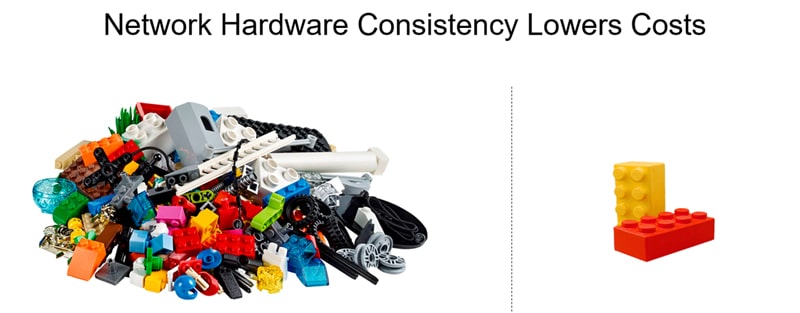On average there are 10-15 different network devices from 2-3 vendors in a traditional network!
Just think about the costs associated with maintaining a robust supply chain with such hardware inconsistency.
Network Hardware: Inconsistency Complicates Network Planning
This network hardware inconsistency complicates network planning and operations. It also increases the cost of spare parts kept in the service provider’s warehouses – typically an additional 10% – in order to offer immediate replacement of any mission-critical hardware element in the network. Procurement and finance teams should consider the impact of that extra inventory on attaining their target/budgeted price.
Distributed Disaggregated Chassis (DDC) Router Model: The Alternative to Traditional Network Hardware
The modern distributed disaggregated chassis (DDC) router model defined by the Open Compute Project (OCP), which is complemented by the Telecom Infra Project DDBR, offers an alternative to chassis-based routers. DDC/DDBR supports scaling of network capacity just by adding white boxes to an existing network infrastructure cluster, acting as a single entity (of up to hundreds of elements in a cluster). This is opposed to a traditional router chassis that forces service providers to buy multiple and varied sizes of boxes from the same family to accommodate different scaling options.
DDC/DDBR uses just two types of basic commercial off-the-shelf (COTS) building blocks that are available from multiple vendors. These two building blocks are common to all types of sites and all network functions (from network routers to firewalls). This makes the cost of spare parts and inventory significantly lower than with traditional network architecture, while shrinking the list of SKUs from a few hundred to only a dozen.

The Impact of Network Hardware Inconsistency
In a typical discussion about network technology, it is rare to mention the network technician whose job is to make sure the network is kept up and running. Network hardware inconsistency has a huge impact on their day-to-day job. You see, the cost for each site visit by a technician is approximately $500-1,000 USD. On average there is a weekly visit to each aggregation and core site, and a monthly visit to each cell site. When something breaks (yep, even with five-9s availability) and needs to be replaced, these poor technicians must drive to the inventory warehouse, fill their vehicles with various spare parts, and rush to the damaged site location. This scenario happens multiple times a year, hugely impacting network operations and associated OpEx.
Shorter MTTR and Efficient Operations: The Importance of Network Hardware Consistency
When more operations shift to software-based, and there is significantly less hardware variation in spare parts, the technician’s job becomes easier and the MTTR (mean time to repair) becomes shorter. Technicians can carry most of the parts in their vehicles and spend less time on the road. As a result, required knowledge of multiple maintenance procedures and sorting of these various spare parts options are reduced significantly – and troubleshooting becomes faster and easier.
The next time you choose a network equipment vendor, keep these two key points in mind:
- Fewer hardware variations, software versions and maintenance procedures make operational processes more efficient and reduce your network’s total cost of ownership (TCO).
- Procurement and finance teams should consider how their network’s infrastructure inconsistency negatively impacts YOUR network costs.
Download eBook
5 Reasons to Include Network Cloud in Your Next RFP




